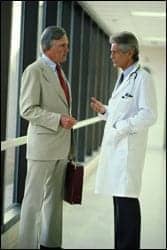 |
Equipment effectiveness and patient safety will always top the priority list for biomedical and clinical engineering departments. For today’s departments, this means maximizing resources to improve multidisciplinary communications within the hospital, as well as building long-term plans and fostering professional growth. Just as no piece of hospital equipment stands alone, today’s biomedical and clinical engineering departments cannot afford to be isolated—and that means adopting several best practices that allow the department to share its valuable expertise throughout the hospital.
Not only do these efforts make day-to-day interactions easier and help the department meet its goals, but they also demonstrate the department’s value within the hospital system. “You always have to make your department visible—so that the organization realizes your value—and promote continued partnerships and involvement in corporate projects,” says Izabella Gieras, director of technology management for Beaumont Services Co, LLC, affiliated with Beaumont Hospitals, Royal Oak, Mich.
Investing your resources in best practices doesn’t have to be expensive, but it does require time and attention to be successful. Below are a few ways to make the most of your department’s resources.
Strengthen Communication
Collecting input from users, administrators, and other departments, such as IT, is vital to every successful project.
“If we’re going to have a successful health care system in general, we all need to work together so that there can be a sharing of knowledge and experiences between all of the different departments,” Gieras says.
It is also important to form strategic alliances with administrators and key clinical leaders. Identify the administrators who will become champions for your department, and find the technically savvy clinical leaders who can help you anticipate future equipment needs.
In meetings, be sure to participate, and be prepared to back up your statements and promises. “You don’t bring problems to them, you bring solutions to them,” says L. Michael Fraai, director of biomedical engineering at Brigham and Women’s Hospital, Boston.
Fostering these relationships means that biomeds are tuned in to the hospital’s ultimate goals. For example, to emphasize patient-centric care, Brigham & Women’s Hospital wanted to install equipment in such a way that the size of the monitors and the number of cables would not intimidate patients, family members, and even clinicians themselves upon entering the room. Knowing that this was a hospital priority helped Fraai’s team rise to the challenge and find a solution.
Reach Out
According to Kevin M. Ferguson, clinical engineer at the Cincinnati Children’s Hospital Medical Center, Cincinnati, a strong relationship with the nursing staff is key to his department’s success, as the nurses will often spot issues with equipment before anyone else. “It’s very important that we’re constantly communicating with them,” he says. “If they feel that something’s not 100%, we want to know what’s bothering them and why.”
Daily interactions foster this relationship and allow biomed professionals to address problems as they arise, but formal meetings have their place as well. Every month, the department director and Ferguson sit down with members of the nursing staff to discuss progress on current plans, equipment needs, and future considerations. This way, both departments know where they stand and how to move forward.
Share Information
It’s no secret that the relationship between the IT/IS and biomedical departments is evolving as rapidly as the technology these departments service. With more devices relying on network connections and frequent software upgrades, creating a team approach involving biomeds and IT is all the more vital.
“We need to be very diligent about the working relationship with those departments and make sure that the equipment that we bring in can work with other pieces of equipment and is safe and effective in delivering patient care,” Gieras says.
Part of this crossover comes into play with software. Biomeds are much more concerned with software than ever before, and building software awareness will work in their favor. Implementing the proper updates and upgrades smoothly without causing disruption or harm carries a lot of responsibility. These days, software often becomes obsolete long before the hardware, so being prepared means communicating closely with vendors and IT departments to ensure that the upgrades are in place according to the schedule. It also means making a plan of 5 years or more to make sure that maintenance goes as projected.
“Software versioning is taking more and more time because pretty much everything—monitors, IV pumps, anesthesia machines—has a software version in it,” Fraai says.
Many departments struggle with how to handle these issues, which often fall in the gap between biomed departments and IT. “I can’t take an IT person and make them do this work,” Fraai says. “And I can’t take a biomed person and think they’re going to understand all the IT issues. You need a hybrid person who’s very well versed in clinical applications because that’s the acquisition point of all of the data.”
Handling these issues often means working more closely with IT, but Fraai believes that biomeds have the fundamental tools to eventually tackle these problems, too. The idea is to use structured thinking to come up with a solution. “You’re not going to be able to know all of the details of everything, but you can use the foundation knowledge to expand on what comes—because it all is basic physics, basic electronics—it’s differently packaged and a different way of using it,” he says.
Training represents another way to enhance communication. Take advantage of training opportunities to help bring clinicians and nurses up to speed on new equipment or functionality. At the first meeting with users, Fraai’s team finds out what they expect from the technology and what functions they would like to use. From there, his team chooses the features that the users will find the most helpful.
“You take out which things can be applied for the clinical need that was expressed to you, and then you meet back with them and say, ‘Based on what we have been talking about, these are the things I think would be relevant,’ ” Fraai says. This helps biomeds understand what questions are likely to arise and allows clinicians and nurses to use the product to its full potential.
Implement Strategic Technology Management
 |
| Finding out what functionality clinicians want enables you to actually match the technology to their needs. |
When it comes to equipment planning, biomed departments must consider the long-term needs to maintain medical equipment and ensure it will continue to meet patient safety and hospital efficiency standards. Making sure equipment fits in with the hospital’s overall growth plan means thinking at least 3 to 5 years ahead.
“The key is to make sure that we have a good team assembled from the very beginning,” Gieras says. This means getting administration backup and working with all of the stakeholders involved in the project.
As part of this plan, it is important to constantly assess how the hospital currently functions and identify future needs. “We take a look at how all of the devices in the hospital impact patients, caregivers, and staff supporting the equipment,” Gieras says. “We incorporate that in our equipment-planning process to ensure that we have a healthy environment within our hospital.”
Taking a systems approach to technology ensures that the workflow for caregivers is satisfactory and that they are not overwhelmed by the technology. It also means taking a close look at processes and constantly fine-tuning them to make sure they are as effective as possible. Below are some examples of effective technology management.
Equipment planning represents an important step. An easy mistake is to go for the Cadillac version of every device instead of weighing the pros and cons of simpler models that might be more cost-effective. “Generally, the functionality that clinicians want is very basic and very simple, and it requires some skills to farm that knowledge so that you can actually match the technology to that needed functionality,” Fraai says.
To find out what will be most effective, ask questions to get to the heart of how the technology will be used. “Ask, how do you use technology effectively?” Fraai says. “What are the fundamentals of it, how does it integrate in the environment of use? Are there better ways of doing something? Can you use a simplified version, or do you need a super, high-end, expensive version that is on the market?”
As with all aspects of hospital planning, equipment planning requires a team approach, especially with front-line users, who can often give input into replacement technology when it is time to bring in a new device.
“Part of that technology is a 4- to 5-year plan,” Ferguson says. “How is this equipment going to fit in with their growth? Is this equipment user-friendly?”
Human factors engineering is another component. Part of successful equipment planning is anticipating problems before you ever bring a device into the hospital. Some departments, like Gieras’, have hired human factors engineers, who focus on making devices safer, more effective, and easier to use.
“This planning process makes use of creative human factors methodologies, focusing on the design of equipment as well as how the users will interact with the equipment in a clinical setting,” she says. “That engineer works very closely with the clinical engineers, biomedical engineering technologists, and the hospital staff to make sure that as we evaluate new medical equipment, we have appropriate protocols in place to ensure that we look at all of the design and operational details of the equipment. If we spot something that we feel could lead to potential errors, we eliminate that technology right off the bat.”
In this same vein, 2 years ago, Gieras’ team established the Beaumont Technology Usability Center (BTUC) to work with medical device manufacturers to create safe technologies, specializing in user-interface design and evaluation. The aim is to improve product design and user-device interfaces before devices are released to the public, in an effort to increase the safety, ease of use, system performance, and user satisfaction of the devices. According to an FDA recall study, design problems account for 44% of medical device recalls. “It’s making sure, amongst many things, that the buttons and labeling are designed well, the font is large enough for the user, that there’s enough light falling on the device—everything from the usability perspective,” Gieras says.
While bringing on a human factors engineer might be ideal, it’s not always feasible for a department’s budget. In those cases, Gieras suggests investing in relatively inexpensive online classes or seminars that offer fundamentals on human factors engineering training so that staff members become more aware of these issues.
Incident investigation also plays a part in technology management. Finding the cause of a device failure or other problem contributes not only to immediate patient and caregiver safety, but also to equipment planning down the line. A problem, such as a clinician pressing the wrong button, could seem superficial at first, but Gieras recommends taking the time to perform root-cause analysis to get to the underlying issue. It could be that the button was mislabeled or too close to another button with a similar design and function, facilitating an inadvertent error.
“We can take a look at the root causes that contributed to the incident, and then we can provide recommendations on how to eliminate them so they do not reoccur,” Gieras says.
In these cases, Gieras and her team at the BTUC make sure they work with medical device manufacturers to improve the design for future models. Gieras’ team also works with clinicians and support staff to explain the cause of the problem and how to avoid it in the future. In some cases where the flaw is dangerous, the device is removed and the team works to find a replacement solution.
Plan for the Future
Biomedical and CE departments may spend most of their day-to-day activities working on current equipment and implementation, but preparing for the future is equally important. Ferguson recommends having an ever-growing and expanding 5- to 10-year plan for the department that coincides with the overall plans for the hospital itself. Often, the hospital’s changing plans directly impact the department’s goals. For example, when Ferguson first joined the department, the hospital decided to expand its research foundation into a 1.2 million-square-foot mega facility. As a result, the department had to adjust its long-term plan.
While the strategy does not necessarily have to be a formal document, it is valuable to give it serious thought. “It’s very dynamic,” Ferguson says. “You have to constantly adjust it and be aware of it. That doesn’t mean that you sit over it every day and worry or make notes and changes, but you know where it stands.”
Boost Professional Visibility
Biomedical and clinical engineering departments constantly seek ways to show their value to hospital administrators—and the first step is clearly defining the department’s role. For L. Michael Fraai, director of biomedical engineering at Brigham and Women’s Hospital, Boston, this means branding the BMET and CE roles as “those who understand the use models of technology and how to match these to clinical caregiving.”
“Everybody has a conceptual idea of what a nurse is,” Fraai says. “But when you say clinical engineer, biomedical engineer, or biomed tech—we all struggle conceptually with what is done. We need to spend a healthy amount of time on how we brand the profession as something that has value to the institution.”
Constant communication and training sessions with clinicians and other personnel go a long way toward building the department’s reputation and demonstrating its expertise. When it comes to communication with clinical personnel and other department representatives, don’t be afraid to ask questions, and always take the initiative to find answers to questions that arise. “Generally, people are very proud to let you know what they know,” Fraai says.
Communication is also the key to the ever-evolving relationship between biomeds and the IT department. Kevin M. Ferguson, clinical engineer at the Cincinnati Children’s Hospital Medical Center, Cincinnati, notes that the IT department at his hospital has created a clinical integration group to work specifically with the biomed department. “We can pull in an IT person that’s got training similar to ours, and we can approach a problem from a systematic point of view,” he says. He adds that IT actually hired a few biomed technicians from his department, which also strengthens the understanding of each other’s roles.
Ferguson has found that regular meetings with IT encourage a team approach and allow both departments to keep abreast of how changing plans in one department will affect the other. It also means addressing problems as they arise. “If we see a problem—whether it’s a personnel problem, an equipment problem, or a vendor problem—one of us calls the other one immediately and asks, ‘What can we do about this?’ ” he says.
Other ways to show value is to find growth areas, and investigate other places in the hospital that could benefit from the expertise of your department. For example, Ferguson is looking to grow into the imaging and lab arenas so that his department can be the first to respond if a problem occurs with the equipment. Of course, this type of growth requires collaboration with administrators and vendors and a clear understanding of what resources will be required.
Some growth projects may require additional personnel—which affects space constraints within the department and the cost of additional test equipment—so it is important to get administrators’ support. “From the administrative point of view, they’re looking at what the value is and how we justify it,” Ferguson says.
There are other ways to round out the department’s expertise—and one is investing in staff training. “Get involved in some activities that might not necessarily be in the scope of the biomed and CE departments today but are directly related to medical technologies,” says Izabella Gieras, director of technology management for Beaumont Services Co, LLC, affiliated with Beaumont Hospitals, Royal Oak, Mich.
This could include strengthening partnerships with IT, learning more about human factors engineering, or even taking the Six Sigma Black Belt courses for process improvement. By investing in the knowledge and skills of the personnel, you increase the department’s value to the hospital and promote professional growth.
Rapidly evolving technology impacts the future of biomed departments. More emphasis on wireless devices and an increased desire for patients to be able to use their home care devices in the hospital pose exciting challenges that these departments will be called on to meet.
“It’s very intimidating the amount of technology that’s being unleashed in the clinical environment,” Fraai says. “And I think biomedical engineers and CEs have unique skills to understand the technology and the caregiving process—the clinical practice models to help bridge the gap.”
Building professional interest is another strategy to use. The number of graduating biomeds is on the decline, according to Ferguson, who notes that lack of awareness of the field is a contributing factor. “Long-term, it’s something that we have to be concerned with,” he says.
These days, the fast-growing field of IT may also attract students who once sought biomed degrees. To attract new BMET and CE recruits, spread the word about the field by speaking at local high schools or vocational schools. Let members of your community know about the field, what it is about, and why it is so vital to hospitals.
Building awareness also means being involved in professional associations and even reaching out to other biomedical departments to share best practices. Gieras suggests attending local and national conferences and seminars, or participating in Webinars, advisory councils, and audio conferences to share ideas for success.
—AC
Ann H. Carlson is a contributing writer for 24×7. For more information, contact .




